-
Countries
-
Data and Analysis
-
Special Focus
-
Crisis Responses
This report provides insights into the profiles, experiences, needs, routes travelled and intentions of migrants transiting through the Western Balkans.
IOM surveyed 1,033 migrants from 1 April to 30 April 2024 in Albania, Bosnia and Herzegovina, Montenegro, North Macedonia, Serbia and Kosovo*.
* References to Kosovo* shall be understood in the context of UN Security Council Resolution 1244 (1999).
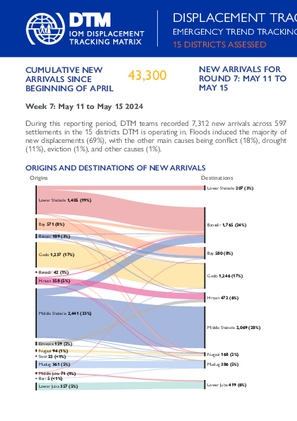
Contact
DTM Somalia, IOMSomaliaDTM@iom.int
Language
English
Location
Somalia
Period Covered
May 11 2024
May 15 2024
Activity
- Mobility Tracking
- Baseline Assessment
This latest round of Emergency Trends Tracking was initiated in April 2024 to monitor displacements movements during the Gu rainy season. Districts covered in this round include Afgooye, Afmadow, Baardheere, Baidoa, Balcad, Belet Weyne, Gaalkacyo, Garoowe, Jamaame, Jowhar, Kismaayo, and Luuq.
ETT is a crisis-based tool that tracks sudden displacement triggered by specific events or emerging crises. The objective of ETT is to help prioritize humanitarian response and to enable partners to deliver rapid assistance. Based on previous shock induced displacement patterns, the humanitarian community expects that people will continue to move toward urban areas in search of humanitarian services. Consequently, the ETT coverage focuses on the main urban centers and surrounding villages for each assessed district. The data is collected through Key Informant Interviews (KIIs) at the location level, from Sunday to Wednesday every week. It includes information on new arrivals, numbers and demographic of IDPs, reasons for displacement, intentions, humanitarian assistance and priority needs among others.

Contact
DTM Mozambique, DTMMozambique@iom.int
Language
English
Location
Mozambique
Period Covered
Dec 05 2023
May 29 2024
Activity
- Mobility Tracking
- Site Assessment
This Multi-Sectorial Location Assessment (MSLA) report, which presents findings from the International Organization for Migration’s (IOM) Displacement Tracking Matrix (DTM) Round 13 assessments, aims to enhance understanding of the extent of internal displacements and the needs of affected populations in conflict-affected and disaster-affected districts of Mozambique. Data was collected between 5 - 29 December 2023 in close coordination with provincial government and Instituto Nacional de Gestão e Redução do Risco de Desastres (INGD) partners, and presents trends from 190 assessed sites hosting internally displaced persons (IDPs) across Northern (Cabo Delgado 95 sites, Nampula 2 sites, Niassa 7 sites), Central Mozambique (Sofala 36 sites, Manica 35 sites, Zambezia 10 sites, Tete 3 sites) and Southern (Inhambane 2 sites).
A total of 317,224 (IDPs were reported present in all 190 sites assessed. This represents a reduction of 19 per cent from MSLA Round 12. Reported figures, however, exclude displaced individuals living in host community settings. According to DTM Round 20 Mobility Tracking Report, as of August, an estimated 709,529 were identified living in both host communities and sites (582,764 IDPs in Northern Mozambique, and 126,765 IDPs in Central Mozambique).
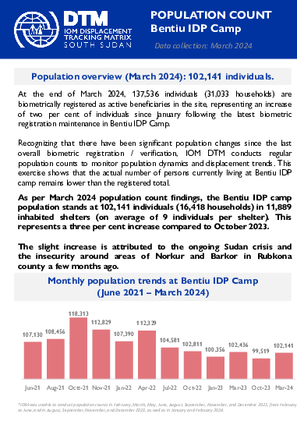
Contact
DTM South Sudan, SouthSudanDTM@iom.int
Language
English
Location
South Sudan
Period Covered
Mar 01 2024
Mar 31 2024
Activity
- Registration
- Flow Monitoring
- Mobility Tracking
- Site Assessment
As per March 2024 population count findings, the Bentiu IDP camp population stands at 102,141 individuals (16,418 households) in 11,889 inhabited shelters (on average of 9 individuals per shelter). This represents a three per cent increase compared to October 2023.
Over the course of 2023, 96,670 arrivals were recorded in Yemen, a one-third increase from 2022 (+32%, 73,200). In fact, by June 2023 (77,130) already had surpassed all the arrivals in 2022. These account for 35% per cent of outgoing movements from the East and Horn of Africa. Three quarters of these arrivals transited through Djibouti, while the remaining quarter crossed the Gulf of Aden from Somalia
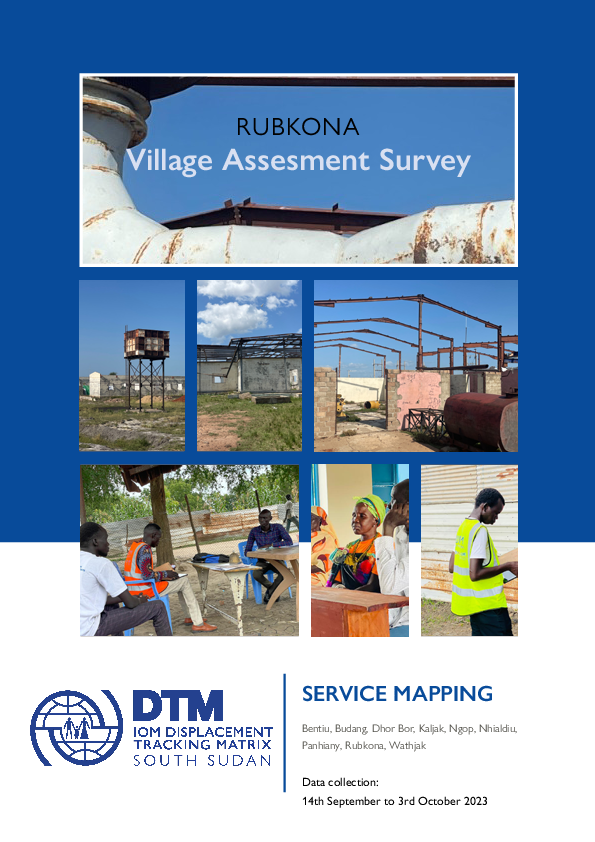
Contact
DTM South Sudan, SouthSudanDTM@iom.int
Language
English
Location
South Sudan
Period Covered
Sep 14 2023
Oct 03 2023
Activity
- Mobility Tracking
- Site Assessment
The data collection took place from September 14th, 2023, to October 3rd, 2023, covering a period of twenty days. The Displacement Tracking Matrix (DTM), a unit of the International Organization for Migration (IOM), conducted a 20-day Village Assessment Survey (VAS) in Rubkona County to assess transition and recovery needs. The survey focused on 09 Payam and 27 bomas accessible, as rainy season and flood limited access to some of the areas.
Of the 76 settlements assessed, 12 were found deserted while 64 remained populated. The survey meticulously mapped 240 facilities, 76 settlements, and 2 livelihood areas across the surveyed bomas. This includes 6 settlements in 6 bomas not assessed due to flooding. Among the 76-settlement identified, there are 37 neighborhoods, 30 permanent villages, 7 IDP sites and 2 temporary sites. The team managed to map 2 livelihood areas categorized into fishery grounds.
KEY FINDINGS
The assessment reveals a substantial number of destroyed or abandoned buildings, emphasizing the pressing need for housing reconstruction initiatives to address the housing crisis in the county.
Many areas within Rubkona County lack access to essential services such as education, healthcare, and markets, indicating a need for targeted interventions to improve service provision and overall community well-being.
In 67% of bomas, the fear of disasters, such as flooding, poses a substantial challenge for peaceful return, emphasizing the impact of environmental factors on human settlements.
A prevalent issue in multiple bomas across Rubkona County is the presence of individuals living on land/property without paying rent or obtaining permission from the owners, with 57% of bomas reporting such instances.
Most residential structures in Rubkona County lack permanency, characterized by the prevalence of temporary shelters such as tents and tukuls. These constructions are primarily composed of mud walls and thatched roofing, indicating a deficiency in durable and lasting housing infrastructure.
Critical need for improvements in school infrastructure, including insecure buildings, classroom shortages, insufficient furniture, and inadequate water and sanitation facilities, to create a conducive learning environment.
Urgent need for renovations, upgrades, and construction of permanent structures in healthcare facilities to ensure a safe environment for patients and healthcare workers.
The pressing need to rehabilitate non-operational boreholes to ensure a reliable water supply. the lack of water user committees in certain bomas inhibits local management of water resources.
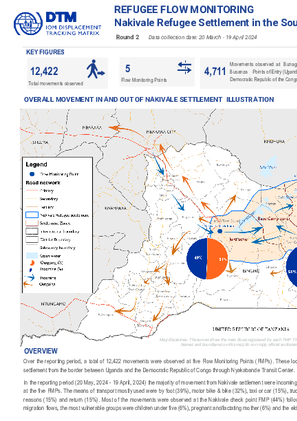
Contact
dtmuganda@iom.int
Language
English
Location
Uganda
Period Covered
Mar 20 2024
Apr 19 2024
Activity
- Flow Monitoring
Over the reporting period, a total of 12,422 movements were observed at five Flow Monitoring Points (FMPs). These locations were chosen strategically as major transit points for monitoring movements in and out of Nakivale settlement from the border between Uganda and the Democratic Republic of Congo through Nyakabande Transit Center.
In the reporting period (20 May, 2024 - 19 April, 2024) the majority of movement from Nakivale settlement were incoming flows (52%) against outgoing flows (48%). Forty-four per cent of the observed movements were refugees at the five FMPs. The means of transport mostly used were by foot (39%), motor bike & bike (32%), taxi or car (15%), truck (8%), bus (3%) and others (2%). The majority of the flows were due to economic reasons (26%), family reasons (15%) and return (15%). Most of the movements were observed at the Nakivale check point FMP (44%) followed by Busanza (19%), Bunagana (19%), Rugaaga (11%) and Nyakabande transit centre (7%). Among migration flows, the most vulnerable groups were children under five (6%), pregnant and/lactating mother (6%) and the elderly (<1%).
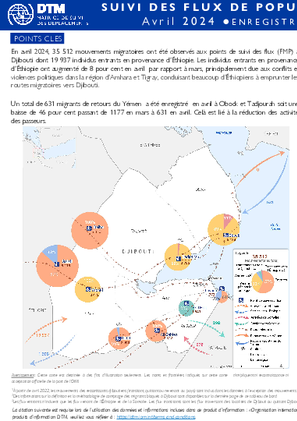
Contact
DTM Djibouti, DTMDjibouti@iom.int
Language
English
Location
Djibouti
Period Covered
Apr 01 2024
Apr 01 2024
Activity
- Flow Monitoring
En avril 2024, 35 512 mouvements migratoires ont été observés aux points de suivi des flux (FMP) à Djibouti dont 19 937 individus entrants en provenance d’Éthiopie. Les individus entrants en provenance d’Éthiopie ont augmenté de 8 pour cent en avril par rapport à mars, principalement due aux conflits et violences politiques dans la région d’Amhara et Tigray, conduisant beaucoup d’Éthiopiens à emprunter les routes migratoires vers Djibouti.
Un total de 631 migrants de retours du Yémen a été enregistré en avril à Obock et Tadjourah soit une baisse de 46 pour cent passant de 1177 en mars à 631 en avril. Celà est lié à la réduction des activités des passeurs.
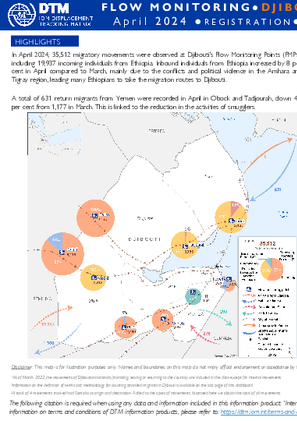
Contact
DTM Djibouti, DTMDjibouti@iom.int
Language
English
Location
Djibouti
Period Covered
Apr 01 2024
Apr 30 2024
Activity
- Flow Monitoring
In April 2024, 35,512 migratory movements were observed at Djibouti's Flow Monitoring Points (FMPs), including 19,937 incoming individuals from Ethiopia. Inbound individuals from Ethiopia increased by 8 per cent in April compared to March, mainly due to the conflicts and political violence in the Amhara and Tigray region, leading many Ethiopians to take the migration routes to Djibouti.
A total of 631 return migrants from Yemen were recorded in April in Obock and Tadjourah, down 46 per cent from 1,177 in March. This is linked to the reduction in the activities of smugglers.

Contact
DTM Pakistan, dtmpakistan@iom.int
Language
English
Location
Pakistan
Period Covered
May 01 2024
May 15 2024
Activity
- Flow Monitoring
The International Organization for Migration (IOM) in Pakistan collects data on the outflows of Afghans at the Torkham (Khyber Pakhtunkhwa), Badini, Bahramcha and Chaman (Balochistan) border crossing points (BCPs) to better understand the movements of Afghans returning to Afghanistan. The data presented below is harmonised with those from the United Nations High Commissioner for Refugees (UNHCR), who also cover Ghulam Khan (Khyber Pakhtunkhwa).
On 26 September 2023, the Ministry of Interior in Pakistan announced its decision to enact its “Illegal Foreigners’ Repatriation Plan (IFRP)”. Between 1 and 15 May 2024, 16,348 Afghan nationals returned to Afghanistan, including 10,043 through the Torkham BCP, 5,909 through the Chaman BCP, 396 through the Ghulam Khan BCP, while no Afghan nationals returned through the Badini and Bahramcha BCPs. In addition, border authorities deported 725 individuals due to a lack of valid documentation. Since 1 January 2024, IOM identified 96,697 returns at the four BCPs.


